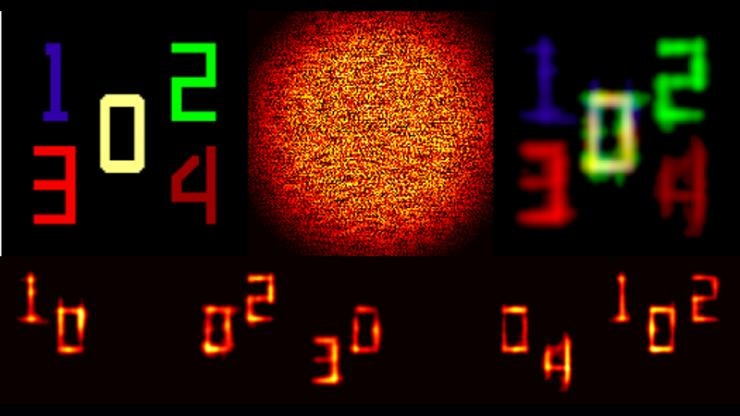Jul 30 2019
Duke University engineers have come up with a novel technique for recovering color images from just a single exposure of light dispersed through an almost opaque material.
 Researchers have created a method that takes light from colored numerals (top left) scattered by a mostly opaque surface (top center) and uses its “speckle” patterns to reconstruct the image in five different frequencies (bottom row) before combining them into a final image (top right). (Image credit: Michael Gehm, Duke University)
Researchers have created a method that takes light from colored numerals (top left) scattered by a mostly opaque surface (top center) and uses its “speckle” patterns to reconstruct the image in five different frequencies (bottom row) before combining them into a final image (top right). (Image credit: Michael Gehm, Duke University)
This latest method can be applied to many different fields, ranging from astronomy to healthcare. The results of the study featured online in the Optica journal on July 9th, 2019.
Others have been able to reconstruct color images from scattered light, but those methods had to sacrifice spatial resolution or required prior characterization of the scatterer in advance, which frequently isn’t possible. But our approach avoids all those issues.
Michael Gehm, Associate Professor, Department of Electrical and Computer Engineering, Duke University
When light travels via a translucent material, it gets scattered and the growing pattern of “speckle” then appears as haphazard as static on a television screen and without any signal. However, this “speckle” is not haphazard. Since the light emerging from a single point of an object travels a very similar path to that of the light emerging from a neighboring point, the speckle pattern from each point appears precisely the same and is only moved slightly.
With a sufficient number of images, astronomers traditionally utilize this phenomenon of “memory effect” to produce more vivid images of the heavens via an unstable atmosphere; however, the objects that are being imaged need to be adequately compact.
Conversely, the method was not preferred for developing adaptive optics, which performs the same kind of job by utilizing modifiable mirrors to offset the scattering effect. Now, recently, the same technique has turned out to be popular once again. Since contemporary cameras are capable of recording an unlimited number of pixels at a given time, a single exposure is sufficient to make the statistics work.
Although this method has the potential to rebuild a scattered image, it has certain restrictions in the world of color. It is generally impossible to disentangle the speckle patterns—produced by different wavelengths—from each other.
This limitation was overcome by the latest memory effect imaging technique devised by the authors Gehm, Xiaohan Li, a PhD student in Gehm’s laboratory, and Joel Greenberg, associate research professor of electrical and computer engineering.
The idea is to utilize a coded aperture and then a prism. A coded aperture, in essence, is a filter that permits light to travel through a few areas—but not others—in a particular pattern. After being “stamped” by the coded aperture, the speckle travels via a prism that promotes different light frequencies to spread out from one another.
This makes the pattern from the coded aperture to shift somewhat with respect to the image being recorded by the detector. The amount it shifts is directly associated with the color of light traveling through.
This shift is small compared to the overall size of what’s being imaged, and because our detector is not sensitive to color, it creates a messy combination. But the shift is enough to give our algorithm a toehold to tease the individual speckle patterns apart from each color, and from that we can figure out what the object looks like for each color.
Xiaohan Li, Study Author and PhD Student, Department of Electrical and Computer Engineering, Duke University
By concentrating on five spectral channels relating to three shades of red as well as green and violet, the method can rebuild a letter “H” that is full of nuanced blues, yellows, and pinks, demonstrated the researchers.
Beyond this complex proof-of-principle, the scientists hope that their method could possibly be used in many different domains, including healthcare and astronomy.
In the astronomy field, the color content of the light emerging from astronomical phenomena consists of useful data about its chemical composition, and the speckle is usually produced as light is twisted by the atmosphere.
Likewise, in the healthcare domain, a color can allow scientists to learn something about the molecular composition of what is being imaged. Alternatively, it can be used for detecting biomolecules tagged with fluorescent markers.
“There are a lot of applications where people really want to know how much energy there is in specific spectral bands emitted from objects located behind opaque occlusions,” Greenberg stated. “We’ve shown that this approach can accomplish this goal across the visible spectrum. Knowing the aperture pattern and how much it shifts as a function of wavelength provides the key we need to disentangle the messy sum into separate channels.”
The Defense Advanced Research Projects Agency (HR0011-16-C-0027) supported the study.